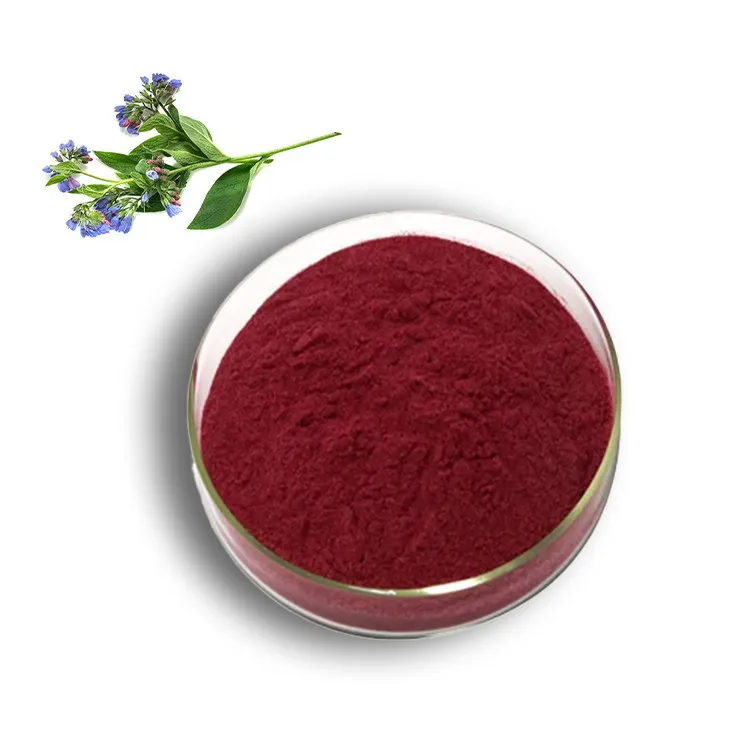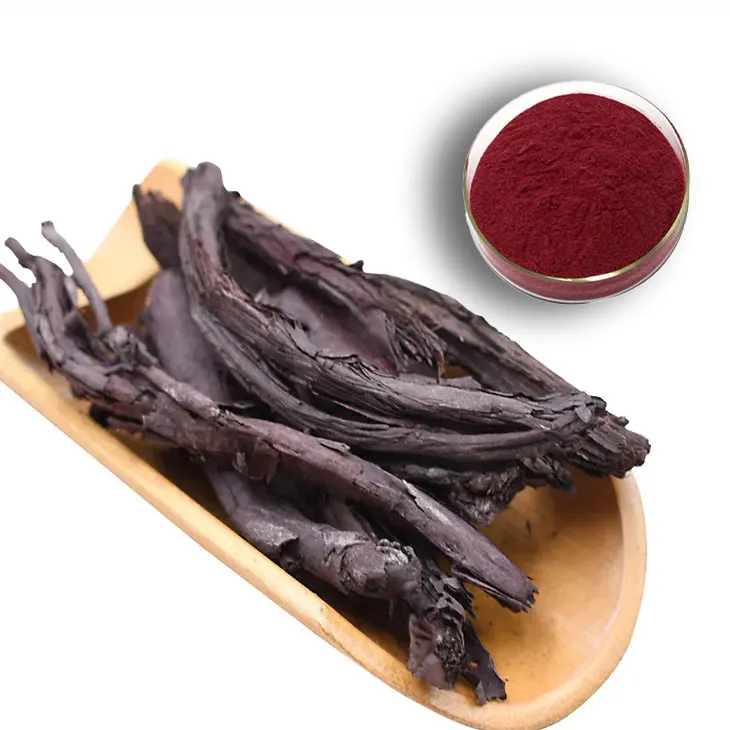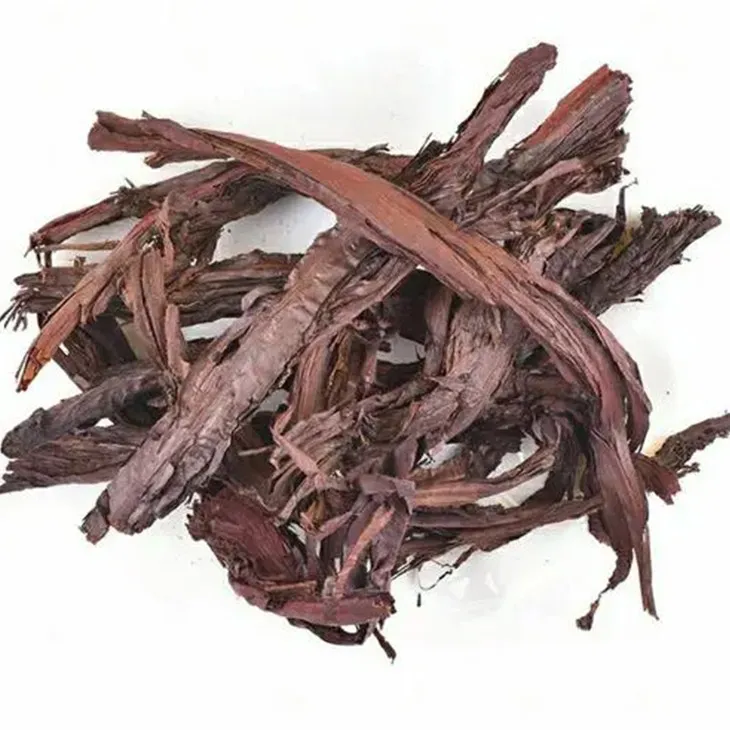- 0086-571-85302990
- sales@greenskybio.com
Shikonin: Uses, Advantages and Manufacturing Processes
2024-11-14

1. Introduction
Shikonin is a natural compound that has attracted significant attention in recent years due to its wide range of applications. It is a naphthoquinone derivative, which is mainly obtained from plants such as Lithospermum erythrorhizon. This compound has been the subject of numerous research studies, revealing its valuable properties in various fields, including medicine, cosmetics, and food.

2. Medical Uses
2.1 Anti - inflammatory Properties
Shikonin has been shown to possess strong anti - inflammatory properties. Inflammatory responses are a natural part of the body's defense mechanism, but when they become chronic or excessive, they can lead to various diseases. Shikonin can interfere with the inflammatory pathways in the body. It can inhibit the production of pro - inflammatory cytokines, which are small proteins that play a crucial role in the inflammatory process. For example, in vitro studies have demonstrated that shikonin can significantly reduce the levels of interleukin - 1β (IL - 1β) and tumor necrosis factor - α (TNF - α) in stimulated immune cells. This anti - inflammatory effect makes it a potential candidate for the treatment of inflammatory diseases such as arthritis.
2.2 Antibacterial Activity
Another important property of shikonin is its antibacterial activity. In the era of increasing antibiotic resistance, the discovery of new antibacterial agents is of utmost importance. Shikonin has been found to be effective against a wide range of bacteria, including both gram - positive and gram - negative bacteria. It exerts its antibacterial effect through multiple mechanisms. One of the mechanisms is by disrupting the bacterial cell membrane. Shikonin can penetrate the cell membrane and cause damage to its integrity, leading to leakage of intracellular components and ultimately cell death. For instance, it has been shown to be effective against Staphylococcus aureus, a common pathogen responsible for various infections, including skin infections and pneumonia.
2.3 Antitumor Effects
Shikonin also shows great potential in the field of oncology. It has been demonstrated to have antitumor properties both in vitro and in vivo. Shikonin can inhibit the growth of certain cancer cells by interfering with their cell cycle progression. It can induce cell cycle arrest at specific phases, preventing cancer cells from dividing and multiplying. For example, in some studies on breast cancer cells, shikonin has been shown to arrest the cells at the G2/M phase of the cell cycle. Additionally, shikonin can also induce apoptosis, or programmed cell death, in cancer cells. It activates the apoptotic pathways within the cancer cells, leading to their self - destruction. This makes it a promising compound for the development of new cancer therapies.

3. Cosmetic Applications
3.1 Antioxidant Properties
In the field of cosmetics, shikonin is highly valued for its antioxidant properties. The skin is constantly exposed to environmental stressors such as ultraviolet (UV) radiation, pollution, and free radicals. These factors can cause oxidative damage to the skin cells, leading to premature aging, wrinkles, and loss of elasticity. Shikonin, as an antioxidant, can scavenge free radicals in the skin. It can neutralize reactive oxygen species (ROS) that are generated as a result of environmental stress. By doing so, it helps to protect the skin from oxidative damage and maintain its healthy appearance. Many skincare products, such as creams and serums, are now incorporating shikonin to enhance their antioxidant capabilities.
3.2 Skin - Repairing Capabilities
Shikonin also has skin - repairing capabilities. It can promote the regeneration of skin cells and accelerate the healing process of damaged skin. This is particularly useful for treating skin conditions such as wounds, burns, and acne scars. Shikonin can stimulate the production of collagen, a protein that is essential for maintaining the structure and elasticity of the skin. By increasing collagen production, it helps to fill in the gaps in the damaged skin and improve its texture. Moreover, it can also reduce inflammation in the skin, which is beneficial for the overall healing process. As a result, shikonin - containing cosmetics are becoming increasingly popular for their skin - rejuvenating effects.

4. Food - Related Applications
Although not as widely studied as in medicine and cosmetics, shikonin also has some potential applications in the food industry. Some research has suggested that shikonin may have antioxidant and antimicrobial properties in food systems. Antioxidants in food can prevent the oxidation of lipids and other components, thereby extending the shelf - life of food products. The antimicrobial activity of shikonin could potentially be used to control the growth of spoilage and pathogenic bacteria in food. However, more research is needed to fully explore its applications in food, especially in terms of safety and regulatory aspects.
5. Advantages of Shikonin
5.1 Natural Origin
One of the major advantages of shikonin is its natural origin. As a compound derived from plants, it is generally considered to be more acceptable to consumers compared to synthetic chemicals. Consumers are increasingly interested in natural products, especially in the fields of medicine and cosmetics. Natural products are often perceived as being safer and having fewer side effects. Shikonin, being a natural compound, has the potential to meet this demand for natural alternatives in various applications.
5.2 Multiple Biological Activities
Another advantage is its multiple biological activities. As discussed above, shikonin exhibits anti - inflammatory, antibacterial, antitumor, antioxidant, and skin - repairing properties. This versatility makes it a very valuable compound. A single compound with multiple beneficial effects can simplify product formulations in various industries. For example, in a skincare product, shikonin can provide both antioxidant and skin - repairing functions, eliminating the need for multiple synthetic ingredients to achieve the same effects.
6. Manufacturing Processes
6.1 Traditional Extraction Methods
Traditional extraction methods of shikonin mainly rely on the extraction from the roots of plants like Lithospermum erythrorhizon. The most common method is solvent extraction. In this process, the plant roots are first dried and ground into a fine powder. Then, a suitable solvent, such as ethanol or methanol, is used to extract shikonin from the powdered plant material. The solvent is chosen based on its ability to dissolve shikonin effectively. After extraction, the solvent is removed, usually by evaporation, to obtain the crude shikonin extract. However, traditional extraction methods often have some limitations. For example, the extraction yield may be relatively low, and the purity of the obtained shikonin may not be very high.
6.2 Modern Techniques
In order to improve the yield and purity of shikonin production, modern techniques are being developed. One such technique is supercritical fluid extraction (SFE). Supercritical fluids, such as supercritical carbon dioxide (sc - CO₂), have unique properties that make them ideal for extraction. They have high diffusivity and low viscosity, which can enhance the extraction efficiency. In SFE, sc - CO₂ is used as the extraction solvent. The pressure and temperature are carefully controlled to maintain the supercritical state of CO₂. This method can selectively extract shikonin from the plant material with higher yield and purity compared to traditional methods. Another modern technique is microwave - assisted extraction (MAE). Microwave energy can be used to heat the plant material and solvent rapidly, which can accelerate the extraction process. MAE has been shown to be an effective method for shikonin extraction, reducing the extraction time and potentially increasing the yield.
7. Conclusion
In conclusion, shikonin is a very promising natural compound with a wide range of uses in medicine, cosmetics, and potentially in food. Its anti - inflammatory, antibacterial, antitumor, antioxidant, and skin - repairing properties make it a valuable asset in various industries. The advantages of being natural and having multiple biological activities further enhance its appeal. Although the traditional extraction methods have been used for a long time, modern techniques are emerging to improve the production of shikonin. With further research and development, shikonin is expected to play an even more important role in the future, providing new solutions for various health and beauty problems.
FAQ:
What are the main applications of shikonin?
Shikonin has diverse applications mainly in medicine, cosmetics, and food. In medicine, it shows anti - inflammatory, antibacterial, and antitumor properties. In cosmetics, it is used for its antioxidant and skin - repairing capabilities. It can also be used in the food industry, although specific uses may vary.
How does shikonin exhibit anti - inflammatory properties?
The exact mechanisms through which shikonin shows anti - inflammatory properties are complex and still under study. However, it is believed that shikonin may interfere with certain signaling pathways in cells related to the inflammatory response. For example, it might interact with proteins or enzymes involved in the production of inflammatory mediators, thereby reducing inflammation.
What are the traditional sources for shikonin extraction?
The traditional extraction of shikonin mainly comes from the roots of plants like Lithospermum erythrorhizon. These plants have been known to contain shikonin, and traditional methods are used to extract this compound from them.
What modern techniques are being developed for shikonin production?
There are various modern techniques being developed for shikonin production. Some of these may include advanced chromatography methods for better purification, genetic engineering techniques to modify the source plants to increase shikonin content, and new extraction methods using supercritical fluids to improve the yield and purity of shikonin production. However, these techniques are still in the research and development stage in many cases.
Why is shikonin considered advantageous in cosmetics?
Shikonin is considered advantageous in cosmetics because of its antioxidant and skin - repairing capabilities. Antioxidants help protect the skin from damage caused by free radicals, which are associated with aging and skin problems. Its skin - repairing capabilities can help in healing damaged skin, reducing wrinkles, and improving overall skin health.
Related literature
- Shikonin: A Review of Its Pharmacological Properties"
- "The Role of Shikonin in Modern Medicine and Cosmetics"
- "Manufacturing Shikonin: Traditional and Innovative Approaches"
- ▶ Hesperidin
- ▶ citrus bioflavonoids
- ▶ plant extract
- ▶ lycopene
- ▶ Diosmin
- ▶ Grape seed extract
- ▶ Sea buckthorn Juice Powder
- ▶ Beetroot powder
- ▶ Hops Extract
- ▶ Artichoke Extract
- ▶ Reishi mushroom extract
- ▶ Astaxanthin
- ▶ Green Tea Extract
- ▶ Curcumin Extract
- ▶ Horse Chestnut Extract
- ▶ Other Problems
- ▶ Boswellia Serrata Extract
- ▶ Resveratrol Extract
- ▶ Marigold Extract
- ▶ Grape Leaf Extract
- ▶ blog3
- ▶ blog4
- ▶ blog5
-
Organic Tongkat Ali extract powder factory.
2024-11-14
-
How to make powder with ashwagandha extract.
2024-11-14
-
Rosehip extract manufacturers from China.
2024-11-14
-
The best cat's claw extract in nature.
2024-11-14
-
Chinese Dandelion Leaf Extract Suppliers.
2024-11-14
-
Soy Extract
2024-11-14
-
Passionflower Extract
2024-11-14
-
Saw Palmetto Extract
2024-11-14
-
Fig Extract
2024-11-14
-
Tormentil Extract
2024-11-14
-
Grapefruit Seed Extract Powder
2024-11-14
-
Quercetin
2024-11-14
-
Hops Extract
2024-11-14
-
Stevia Extract
2024-11-14
-
Cocoa Extract
2024-11-14





















